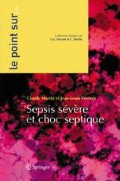Preview
Unable to display preview. Download preview PDF.
Références
Corrigan JJ, Ray WL, May N (1968) Changes in the blood coagulation system associated septicemia. N Engl J Med 279: 851–6
Esmon CT (1998) Inflammation and thrombosis: mutual regulation by protein C. Immunologist 6: 84–9
Vallet B, Wiel E (2001) Endothelial cell dysfunction and coagulation. Crit Care Med 29: S36–41
Levi M, ten Cate H (1999) Disseminated intravascular coagulation. N Engl J Med 341: 586–92
Marshall JC (2001) Inflammation, coagulopathy, and the pathogenesis of multiple organ dysfunction syndrome. Crit Care Med 29: S99–106
Ruggeri ZM (1994) New insights into the mechanisms of platelet adhesion and aggregation. Semin Hematol 31: 229–39
Cines DB, Pollak ES, Buck CA et al. (1998) Endothelial cells in physiology and pathophysiology of vascular disorders. Blood 91: 3527–61
Rao LVM, Rapaport SI (1987) Studies of a mechanism inhibiting the initiation of the extrinsic pathway of coagulation. Blood 69: 645–51
Esmon CT (1989) The roles of protein C and thrombomodulin in the regulation of blood coagulation. J Biol Chem 264: 4743–6
Stearns-Kurosawa DJ, Kurosawa S, Mollica JS et al. (1996) The endothelial cell protein C receptor augments protein C activation by thrombin-antithrombomodulin complex. Proc Natl Acad Sci USA 93: 10212–6
Walker FJ (1981) Regulation of activated protein C by protein S: the role of phospholipid in factor Va inactivation. J Biol Chem 256: 11128–31
Astrup T (1991) Fibrinolysis: past and present. A reflection of fifty years. Sem Thromb Hemost 17: 161–74
Esmon CT (1999) New potential therapeutic modalities: aPC. Sepsis 3: 161–71
Nawroth PP, Handley DM (1986) Modulation of endothelial cell hemostatic properties by tumor necrosis factor. J Exp Med 163: 740–5
Faust SN, Levin M, Harrison OB et al. (2001) Dysfunction of endothelial protein C activation in severe meningococcal sepsis. N Engl J Med 345: 408–16
Coughlin SR (1994) Thrombin receptor function and cardiovascular disease. Trends Cardiovasc Med 4: 77–83
Voss R, Matthias FR, Borkowski G, Reitz D (1990) Activation and inhibition of fibrinolysis in septic patients in an internal intensive care unit. Br J Haematol 75: 99–105
Eisele B, Lamy M, Thijs LG et al. (1998) Antithrombin III in severe sepsis. A randomized, placebo-controlled, double blind multicenter trial plus a meta-analysis on all randomized, placebo-controlled double blind trials with antithrombin III in severe sepsis. Intensive Care Med 24: 663–72
Warren BL, Eid A, Singer P et al. (2001) Caring for the critically ill patient. High-dose antithrombin III in severe sepsis: a randomized controlled trial. JAMA 286: 1869–78
Abraham E, Reinhart K, Opal S (2003) Efficacy and safety of tifacogin (recombinant tissue factor pathway inhibitor) in severe sepsis: a randomized controlled trial. JAMA 290: 238–47
Bernard GR, Vincent JL, Laterre PF et al. (2001) Efficacy and safety of recombinant human activated protein C for severe sepsis. N Engl J Med 344: 699–709
Warren HS, Suffredini AF, Eichacker PQ, Munford RS (2002) Risks and benefits of activated protein C treatment for severe sepsis. N Engl J Med 347: 1027–30
Siegel JP (2002) Assessing the use of activated protein C in the treatment of severe sepsis. N. Engl. J. Med 347: 1030–4
Angus DC, Linde-Zwirble WT, Clermont G (2003) Cost-effectiveness of dotrecogin alfa (activated) in the treatment of severe sepsis. Crit Care Med 31: 1–11
Davidson BL, Geerts WH, Lensing AWA (2002) Low-dose heparin for severe sepsis. N Engl J Med 347: 1036–7
Kerlin BA, Yan SB, Isermann BH (2003) Survival advantage associated with heterozygocis factor V Leiden mutation in patients with severe sepsis and in mouse endotoxemia. Blood 102: 3085–92
Dhainaut JF (2000) Sepsis et hémostase: nouvelles perspectives thérapeutiques. Reanim Urg 9(suppl 2): 51–63
Rights and permissions
Copyright information
© 2005 Springer-Verlag France
About this chapter
Cite this chapter
Martin, C., Vallet, B., Wiel, E. (2005). Interférences avec l’hémostase. In: Sepsis sévère et choc septique. Le point sur⋯. Springer, Paris. https://doi.org/10.1007/2-287-27496-0_17
Download citation
DOI: https://doi.org/10.1007/2-287-27496-0_17
Publisher Name: Springer, Paris
Print ISBN: 978-2-287-22072-2
Online ISBN: 978-2-287-27496-1
eBook Packages: MedicineMedicine (R0)

